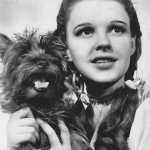After Disney’s Snow White showed that children’s stories could be profitable, MGM bought the rights to L. Frank Baum’s 1900 novel The Wonderful Wizard of Oz, about the adventures of Kansas farm girl Dorothy and her dog Toto in the magical land of Oz. The book had been adapted as a 1902 stage musical and three silent films, but MGM’s version is the best-known, considered one of the greatest films and a cultural icon.
Directed primarily by Victor Fleming, with songs by Harold Arlen and Yip Harburg, the 1939 film The Wizard of Oz stars Judy Garland (Dorothy), Ray Bolger (Scarecrow), Jack Haley (Tin Man), Bert Lahr (Cowardly Lion), Billie Burke (Glinda), Margaret Hamilton (Wicked Witch), Frank Morgan (Wizard) — and Terry (Toto).
The screenplay is among the most quoted in pop culture. Noel Langley, Florence Ryerson, and Edgar Allan Woolf are credited as the writers, but the script went through several hands. Producer Mervyn LeRoy hired Langley, Herman J. Mankiewicz, and Ogden Nash to write separate versions. Ryerson and Woolf were asked to compile the final script. However, associate producer Arthur Freed was unhappy with their work and reassigned it to Langley. During filming, Fleming and screenwriter John Lee Mahin made further revisions, and the final draft was delivered October 8, 1938.
The major change from the book is that Oz is an elaborate dream and not a true fantasy world. Another notable change is Dorothy’s shoes. In the book, they were silver, but Adrian (MGM’s chief costume designer) chose ruby to take advantage of the new Technicolor process used on the film.
Several changes in casting were also made before filming began. Bolger was originally to be the Tin Man and Buddy Ebsen the Scarecrow, but Bolger asked LeRoy to switch, and Gale Sondergaard was the original Wicked Witch but became unhappy when the character went from glamorously evil (like Snow White’s Queen) to clichéd hag. MGM contract player Margaret Hamilton replaced her three days before production began.
Filming started October 13 at the MGM lot in Culver City, with Richard Thorpe as director, replacing Norman Taurog, who had only shot a few Technicolor tests. Nine days later, LeRoy shut down production to find another director and filming resumed November 3, with Victor Fleming at the helm.
Production was again interrupted ten days into the shoot, when Ebsen suffered a reaction to the aluminum powder in his makeup and left the film, replaced by Jack Haley. Another incident involved a concealed elevator that lowered Hamilton below the soundstage as fire and smoke erupted to dramatize (and conceal) her exit from Munchkinland. On the second take, the burst of fire came too soon and ignited her copper-based makeup, causing third-degree burns on her hands and face. It was three months before she returned.
Then on February 12, 1939, Fleming was called away to replace George Cukor on Gone with the Wind. The next day, King Vidor was on set to finish principal photography (including the “Over the Rainbow” sequence), which ended March 16. Reshoots and pick-up shots were led by LeRoy, and test screenings began June 5, which led to about 15 minutes of cuts. “Over the Rainbow” was nearly one. MGM execs felt it made the Kansas sequence too long, but LeRoy, Freed, and Fleming fought to keep it in.
The New York premiere was followed by a live performance from Garland and Mickey Rooney, who did so after each screening for the next three weeks, with Bolger and Lahr replacing Rooney for the final week. The film opened nationwide on August 25 and was met with widespread acclaim. Film Daily wrote, “Seldom if indeed ever has the screen been so successful in its approach to fantasy and extravaganza,” and the movie placed #7 on its year-end Top 10.
The film received six Oscar nominations, including best picture, winning for Herbert Stothart’s score and Arlen and Harburg’s song “Over the Rainbow.” Garland also won an honorary award for her performance. Despite the film’s success, MGM only broke even on its $3 million investment, the studio’s most expensive production at the time, not earning a profit until the 1949 re-release.
In 1956, CBS was first to broadcast the film, beginning an annual tradition. In 1989, The Wizard of Oz was in the inaugural class of the Library of Congress National Film Registry. It ranked #6 on American Film Institute’s 1998 list of 100 movies, while “Over the Rainbow” was #1 on AFI’s 2004 list of 100 songs and #1 on RIAA’s Songs of the Century. AFI’s 2005 list of 100 quotes included three from the film: Dorothy’s “Toto, I’ve a feeling we’re not in Kansas anymore” (#4) and “There’s no place like home” (#23) and the Wicked Witch’s “I’ll get you, my pretty — and your little dog, too!” (#99).
There was an official 1972 sequel, the animated Journey Back to Oz starring Garland’s daughter Liza Minnelli, and a 1975 MGM comic book adaptation, Marvelous Wizard of Oz, but the “great and powerful Oz” remains the 1939 classic.
Listen to the soundtrack, then rent or purchase the film through Amazon Prime. There is a cottage industry of information about the making of the movie, but one of the best is The Wizardry of Oz (2004) by Jay Scarfone and William Stillman.
NEXT, explore the next phase of Garland’s career with Girl Crazy (1943), the last and best of the Mickey & Judy “let’s put on a show” musical films, featuring songs by George and Ira Gershwin, including the lavish “I Got Rhythm” directed by Busby Berkeley. Listen to the soundtrack, then rent or purchase the film through Amazon Prime.
THEN, look for Holiday Inn (1942), featuring Irving Berlin’s Oscar-winning “White Christmas,” sung by Bing Crosby, which became the world’s best-selling single and ranked #2 on RIAA’s Songs of the Century. Listen to the soundtrack, then rent or purchase the film through Amazon Prime.

